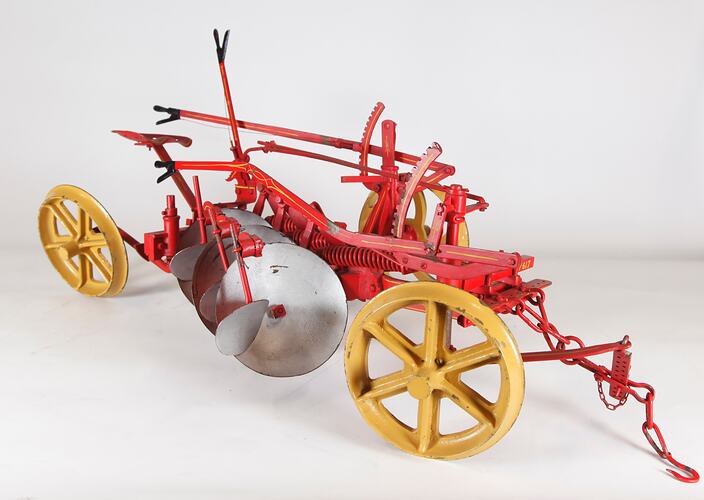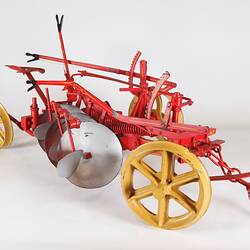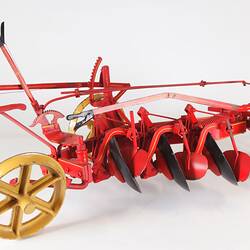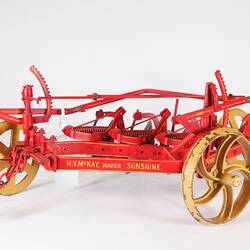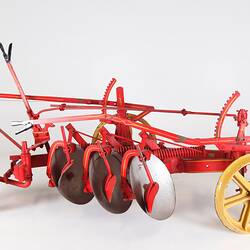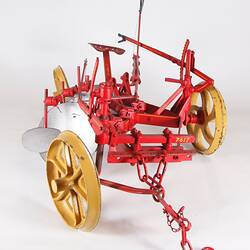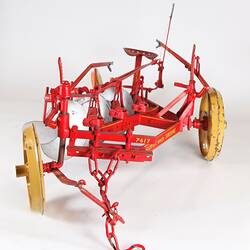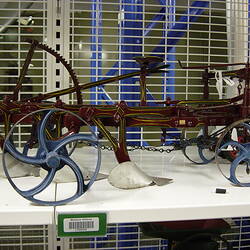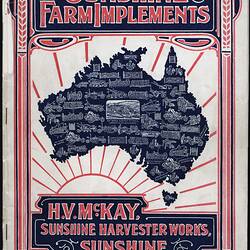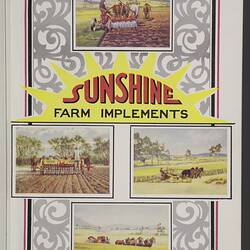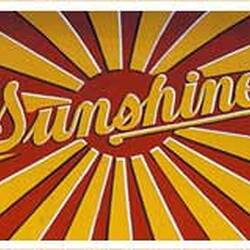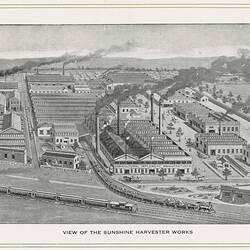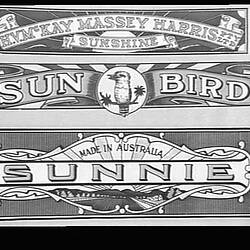Summary
Model of a 'Sunrise' three-furrow stump jump disc plough. Model made by H.V. McKay, Sunshine, Victoria, before 1915.
The 'Sunrise' stump jump disc plough was first introduced in early 1906 as part of a new range of cultivating implements added to H.V. McKay's product line following his takeover of the Braybrook Implement Works in Melbourne's western suburbs. This plough was invented for McKay by one of Victoria's best-known and most celebrated ploughmakers, J. B. Garde, who McKay had recruited specifically to head up his tillage implement department. The design featured a patent stump jump mechanism employing a strong spiral spring and toggle arrangement and had three hand levers to control steering, angle and depth of cut. There was also a metal seat for the operator to ride on the plough. The 'Sunrise' label was the first new brandname derived by H.V. McKay as a variant of his core 'Sunshine' brandname under which his harvesters had gained nationwide fame in the decade from 1895. The new brandname cleverly related to the key feature of the implement's design, the stump-jump mechanism, which enabled each plough share (or disc) to rise or jump over obstacles such as stumps, roots or stones, and marked the beginning of a tradition in which the firm would develop a range of over 50 brandnames all beginning with root 'Sun', which continued to be used for key production lines under the McKay enterprise for the next 50 years.
The 'Sunrise' stump-jump disc plough was a fallowing implement designed for initial ploughing of roughly cleared land on which stumps or stones abounded. The 'Sunrise' plough became the most popular implement with settlers in the Mallee country and other closer settlement areas cultivating virgin country. By its use many thousand acres of roughly cleared land were tilled years before they would have been fit for cultivation by an ordinary 'set' plough.
The 'Sunrise' stump-jump plough was initially offered as a horse-drawn implement in either mouldboard or disc form with any number from two to six furrows and remained in production in essentially the same form until 1940. From 1930, a tractor-drawn version was also offered in six to eight furrows, with an "automatic power lift" to raise and lower the plough shares or discs and in this later form it continued to be manufactured at Sunshine until 1956.
More Information
-
Collection Names
-
Collecting Areas
-
Acquisition Information
Donation from Mr Hugh Victor McKay, 10 May 1915
-
Manufacturer of Item Modelled
H.V. McKay, Sunshine Harvester Works, Sunshine, Greater Melbourne, Victoria, Australia, 1906-1915
-
Inventor
J. B. Garde - H.V. McKay Pty Ltd, Sunshine Harvester Works, Braybrook, Greater Melbourne, Victoria, Australia, 1906
-
Modelmaker
H.V. McKay, Sunshine Harvester Works, Sunshine, Greater Melbourne, Victoria, Australia, 1906-1915
-
Brand Names
-
Classification
Agriculture & rural life, Crop management - ploughing, Model disc ploughs - stump jump
-
Category
-
Discipline
-
Type of item
-
Overall Dimensions
80 cm (Length), 44 cm (Width), 34 cm (Height)
-
References
[Link 1] viewed 12.05.2008 LDH
[Article] Dale-Hallett, Liza, et al. 'The McKay Collection', in Rasmussen, Carolyn. A Museum for the People: A History of Museum Victoria and its predecesors, 1854-2000. pp.271-273., 2001
[Article] 2003. "Resurrecting the Sunshine Harvester Works: Re-presenting and Reinterpreting the Experience of Industrial Work in Twentieth-Century Australia", Labour History., 2003
[Article] Dale-Hallett, Liza. 2004. "Collecting by Stealth: the HV McKay Collection", Museum Victoria Magazine., 2004
-
Keywords
Ploughs, Agricultural Equipment, Stump Jump Ploughs, Furrows
